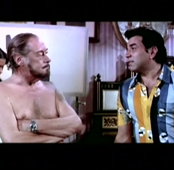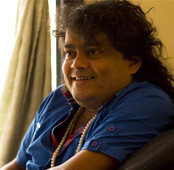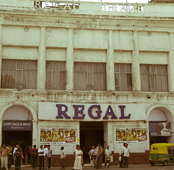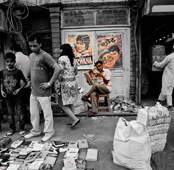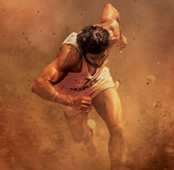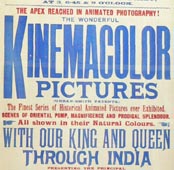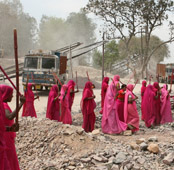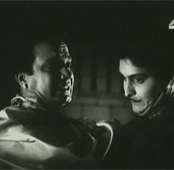-
 Modern Tailors, off Ferozepur Road, Lahore – ‘Specialist: Pant-Coat’ (Photo Credit: Mira Hashmi)
Modern Tailors, off Ferozepur Road, Lahore – ‘Specialist: Pant-Coat’ (Photo Credit: Mira Hashmi) -
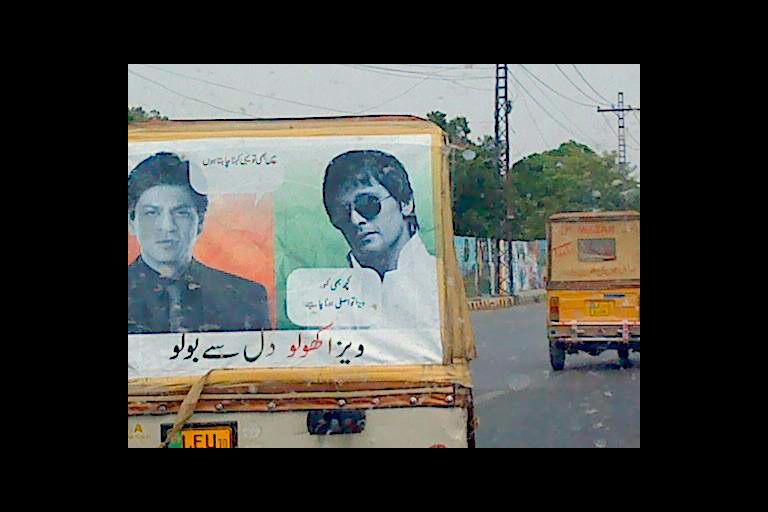 Poster on the back of a rickshaw in Lahore, with Pakistani TV show host Sahir Lodhi who styles himself after Shah Rukh Khan (Photo Credit: Mira Hashmi)
Poster on the back of a rickshaw in Lahore, with Pakistani TV show host Sahir Lodhi who styles himself after Shah Rukh Khan (Photo Credit: Mira Hashmi) -
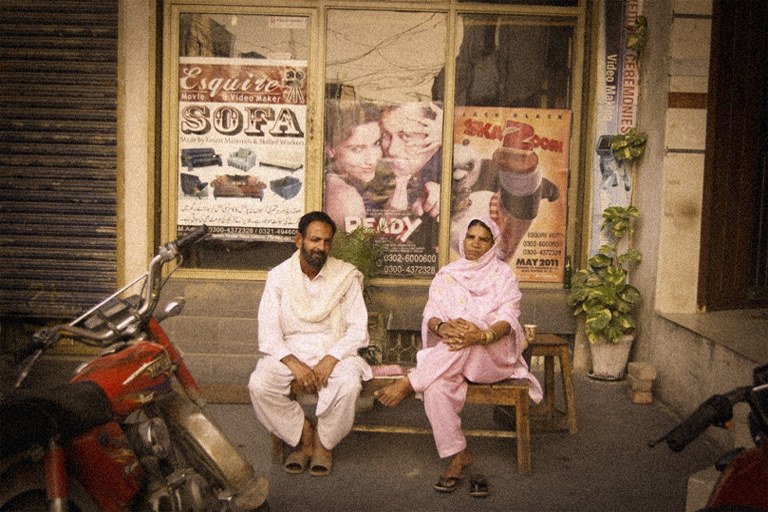 A couple takes a breather on a bench outside DJ Sameer’s, Lahore (Photo Credit: Mira Hashmi)
A couple takes a breather on a bench outside DJ Sameer’s, Lahore (Photo Credit: Mira Hashmi) -
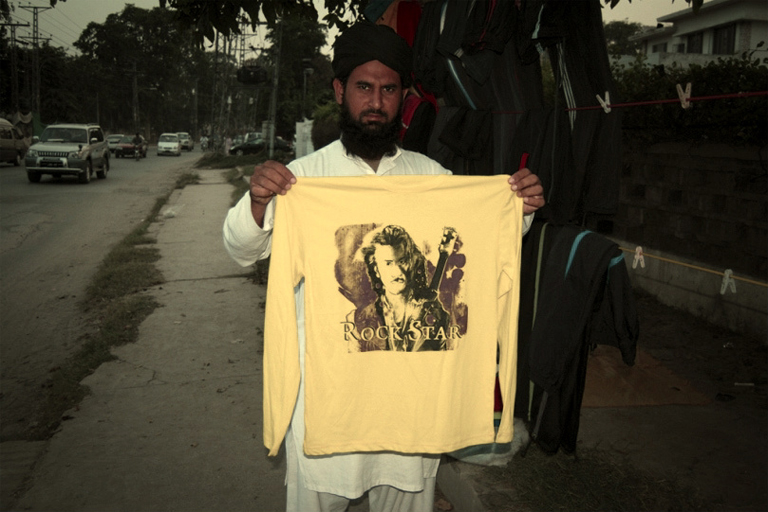 A t-shirt vendor on Lahore’s M.M. Alam Road sells a tee with Ranbir Kapoor as Rock Star (Photo Credit: Mira Hashmi)
A t-shirt vendor on Lahore’s M.M. Alam Road sells a tee with Ranbir Kapoor as Rock Star (Photo Credit: Mira Hashmi) -
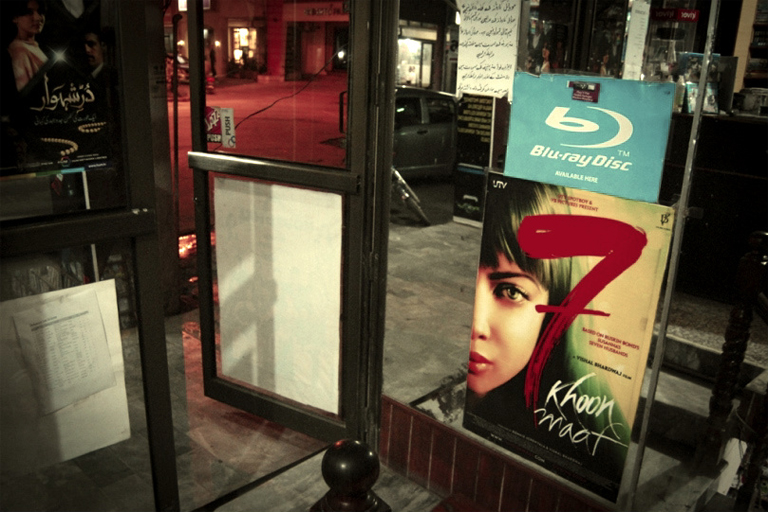 Poster for Saat Khoon Maaf and Pakistani mega-serial Humsafar at the Laserama video/DVD store in Lahore's suburb of Model Town (Photo Credit: Mira Hashmi)
Poster for Saat Khoon Maaf and Pakistani mega-serial Humsafar at the Laserama video/DVD store in Lahore's suburb of Model Town (Photo Credit: Mira Hashmi) -
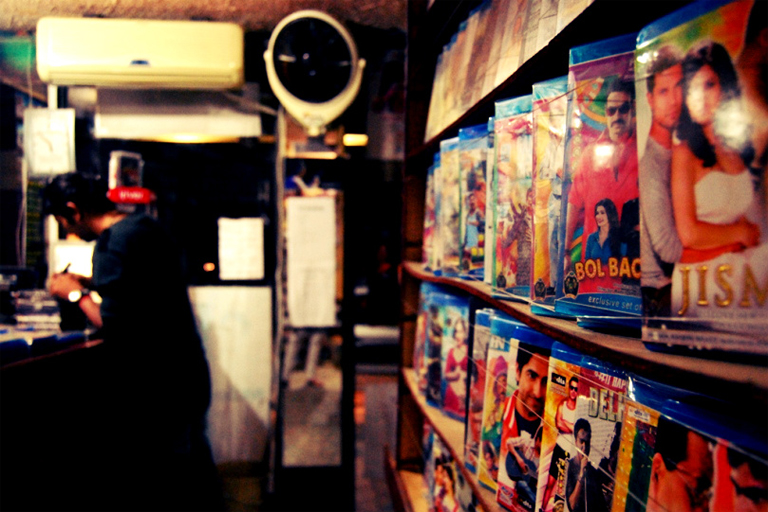 Locally produced ‘Blu Ray’ copies at Laserama (Photo Credit: Mira Hashmi)
Locally produced ‘Blu Ray’ copies at Laserama (Photo Credit: Mira Hashmi) -
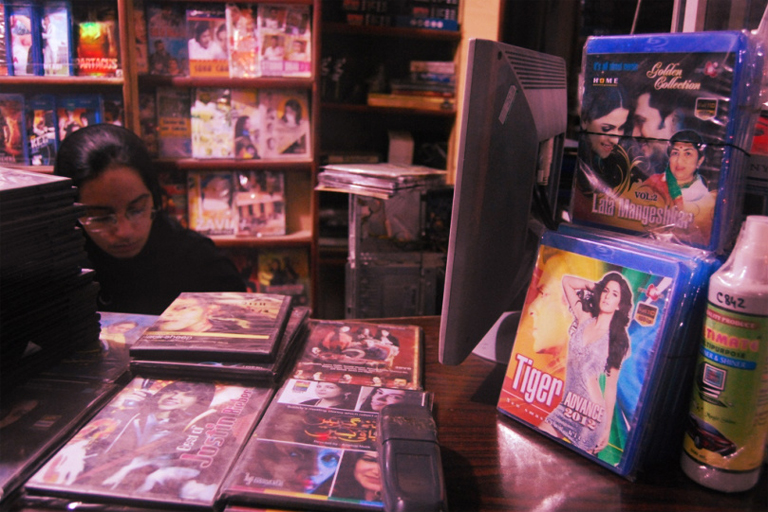 Cashier at Laserama (Photo Credit: Mira Hashmi)
Cashier at Laserama (Photo Credit: Mira Hashmi) -
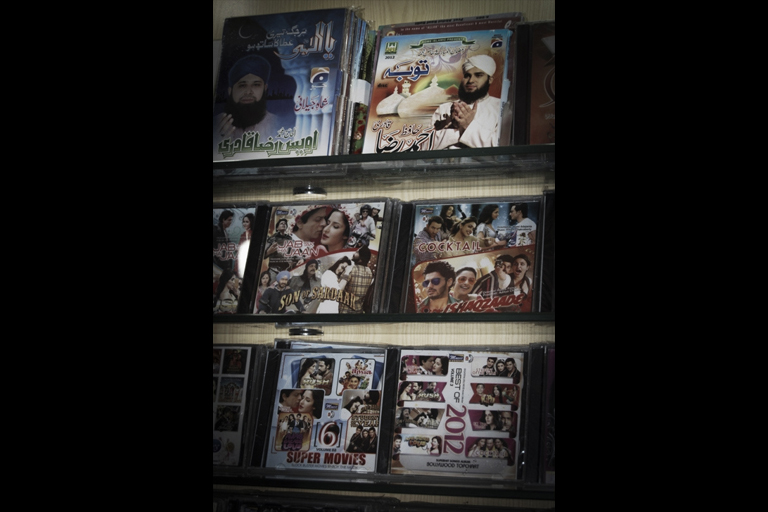 Shehzad store in Liberty Market, Lahore, stocks Indian films and religious sermons on DVD, side by side (Photo Credit: Mira Hashmi)
Shehzad store in Liberty Market, Lahore, stocks Indian films and religious sermons on DVD, side by side (Photo Credit: Mira Hashmi) -
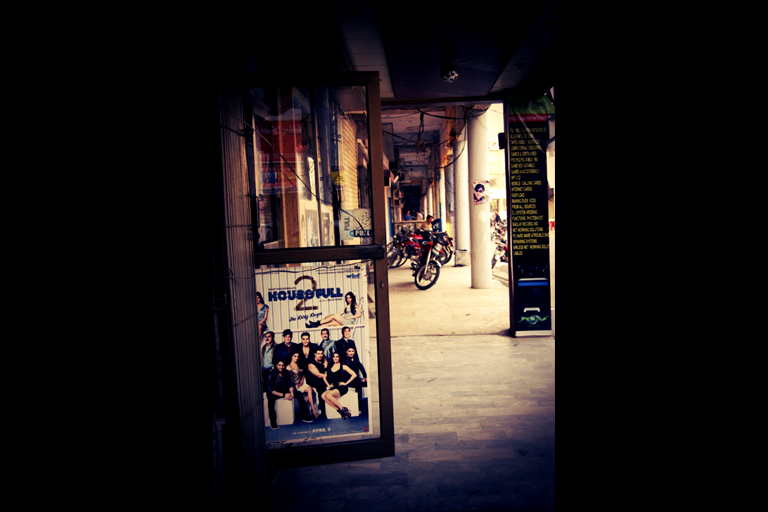 A poster for Housefull 2 at Laserama (Photo Credit: Mira Hashmi)
A poster for Housefull 2 at Laserama (Photo Credit: Mira Hashmi)
Mira Hashmi on Pakistan’s paradoxical and puzzling relationship with Hindi cinema
Her name was Sardar Bibi on her identity card but, in the great Punjabi tradition of conjugating proper nouns, everyone called her Sardaran. She was a widow in her sixties and her daughter Meena was my nanny. Sardaran did odd-jobs around the house, cooked the chapatis, and at night taught me old Punjabi folk songs and narrated fables about wayward monkeys and ticks that exploded in rivers of blood after having a tad too much to drink. This was the early 1980s and the VCR had only just entered our collective consciousness, and with Indian films banned from Pakistani cinemas since 1965, pirated videos of Bollywood fare, though not available in great abundance, were the newest guilty pleasure, one more in a long line of declared cultural taboos in the wake of General Zia’s bid for ‘Islamization’. (This split between official line and ground reality often gave rise to absurdities of farcical proportions, such as the state television channel being instructed to never mention India by name, resulting in Dilip Kumar’s return to Mumbai after a trip to Lahore, in 1988, being covered in news bulletins with the sentence ‘Humsaya mulk ke adaakar, jo humsaya mulk se chand roz ke dauray par aaye the, aaj shaam waapis humsaya mulk ke liye ravaana ho gaye.’ And I shall also never forget the night I heard the moulvi at our neighbourhood mosque reciting a naat—devotional verses—set to the tune of Roop suhana lagta hai, chaand purana lagta hai.)
When word got around that the Hashmi household had acquired a National VCR (but nothing to watch on it), a kind family friend lent us two films from his Dubai shopping: Naseeb and Suhaag – both Amitabh Bachchan starrers. For about a month, all the kids plus the household help would sit huddled together in front of the TV after lunch and religiously watch either of the two films every single day. It was sometime during this ongoing exercise that Sardaran declared that Bachchan was her long-lost son. Our kitchen, which was her domain, became a shrine to the star, with posters and pictures adorning all the cupboards. Over the next few years, she only managed to see one or two more of The Angry Young Man’s films, but her mantra remained unchanged, unshakeable: Bachchan was her son. She managed to convince the local electrician of the veracity of her claim but the rest of us would only giggle and smirk in response and treat it as the joke that we felt it was. It was only many years later, after she had passed away, that we learned from her family that as a young woman during the upheaval of Partition, Sardaran had been separated from her infant son, whom she never saw again. She prayed that the lost child had been found by a good family who raised him as their own and, somewhere in her heart, she hoped that he had grown up to be a handsome, successful, famous and adored man— someone exactly like Mr. Bachchan.
On a warm, humid Lahore evening, three days after Rajesh Khanna’s death on July 18, a group of friends and I sat together in his memory, singing Bheegi bheegi raaton mein and watching him woo Zeenat Aman on the projector in my cozy living room. We were plunged into darkness every now and then with the constant power ‘load-shedding’ that has been a staple of our daily lives for the past five years, but our spirits were not to be dampened. With strings of motia wrapped around our wrists, we munched on pita bread and hummus and sang and reminisced about our movie memories of Kakaji, and amidst this I was suddenly reminded of Sardaran, and the deep, almost inexplicable connection that innumerable Pakistanis have with Hindi cinema. After all, politically, we have always been ‘enemy countries’, having fought three official wars and countless unofficial ones, and with much suspicion of the other to be had on either side of the divide. There is intelligence surveillance, political one-upmanship, media tu-tu-main-main, police-reporting visas, and visa application processes that’ll make you wish you’d never been born— and yet, there is also a strange kind of affinity, an underlying, seductive fascination that at once repels and attracts us to the Other— sort of like the Hollywood films in the 80s where both the villain and the love interest would be those darned Russkies. In official forums, there is resistance and denial (even as Hindi films were allowed back onto Pakistani screens some five years ago), but on the ground, the unembellished reality is that today Bollywood informs our cultural landscape more than our own local cinema. Lollywood, as our film industry, based primarily in Lahore, is referred to, was supposed to benefit from the ban on Hindi films because it would, in theory at least, allow home-grown cinema to flourish unhindered by rival product. That theory was, of course, inherently flawed and in the face of zero competition, not to mention Zia’s destructive cultural policies, Lollywood eventually (and inevitably) floundered. Today, there is reverence and nostalgia for our legends, like Madam Noorjehan, Santosh Kumar, and Waheed Murad, but Lollywood, for all effects and purposes, and due to our own acute myopia, has become irrelevant to the larger picture. Our radio stations now play Indian filmi sangeet, our up-market movie houses show The Dirty Picture and Ra.One, our weddings see the young ‘uns performing choreographed dances to Oo la la and Chammak challo, we cry with Aamir Khan during every episode of Satyamev Jayate, we know the inner and outer worlds of Shahrukh Khan inside and out, Katrina Kaif and Shilpa Shetty smile benignly at us from billboards, and we hang on to every bit of Bollywood gossip about Saifeena that floods the internet. (We also laugh ourselves silly when Hindi TV channels spell it ‘Abhi na jao chod kar ke dil abhi bhara nahi’, but I’ll save that for another day).
The internet has obviously made it that much easier to have the world, including that of Hindi ‘fillums’, at our fingertips, but even in the years way back when Gates and Jobs were just pimply-faced geeks getting copies of Asimov kicked in their faces at the beach, Hindi cinema managed to very much be a part of our lives in an oddly organic fashion. Apart from the trickle-turned-surge of Hindi movies on VHS that led to a mushrooming of video rental outfits all over the country, local book stores started stocking smuggled issues of Filmfare, Stardust and (now long defunct) Star & Style. Only a few precious (and terribly expensive) copies of each would make it across and then would be passed from fan to rabid fan, dog-eared and creased, each article and interview and photograph pored over and dissected and discussed incessantly. It was through this network that we came to keep ourselves updated with Amitabh Bachchan’s recovery after his infamous accident on the set of Coolie. (My cousins had made a pact that they would watch the new VHS of Laawaris only if/when the star succumbed to his injury; I arrived home from school one day to, horror of horrors, see them viewing the film. “Is he…?” I asked in a trembling voice. “Nah, we just got tired of waiting and thought, what the hell?”). This was also how it got around like wildfire among Pakistan’s female population that the frizzy-haired girl in red in the song Papa kehte hain from Qayamat Se Qayamat Tak was hero Aamir Khan’s wife, thereby shattering a million teenage dreams, in unison with those in India I imagine.
And then there was, of course, Chitrahaar! It is nigh impossible to explain to the YouTube generation just what an esteemed place this film song show held in our hearts. Twice a week, we would await it eagerly, singing along to the ads for Nirma Washing Powder and Vicco Turmeric Ayuvedic Cream that signaled the imminent arrival of Chitrahaar, our beloved window into Bollywood’s past, present and future. Perhaps it’s nostalgia speaking, but the instant gratification that the 24-hour Bollywood content TV channels offer today, simply doesn’t compare to the sense of heightened anticipation that Doordarshan used to elicit back in the day with their banner programme.
There are hazy memories of a screening of the 1967 Meena Kumari starrer Noor Jehan, which, for reasons now consigned to the planes of bureaucratic amnesia, was allowed to have a limited release in Pakistan sometime in the late seventies, but I remember very clearly the thrill of watching a Hindi film in the cinema for what I consider the first ‘real’ time, when I visited Delhi and was whisked off to see Jaane Bhi Do Yaaro, in 1984. Many years after that, I was in Mumbai making a documentary on Madam Noorjehan and got to meet my cinematic idols, Gulzar, Dilip Kumar, Dev Anand among them, and though I tried to appear unfazed, the truth is that I could barely contain myself. The monumental sense of awe I had felt in the presence of the subject of the film I was working on, was duplicated during interviews with Lata Mangeshkar and Naushad, and I was acutely aware of my ridiculously good fortune. Perhaps dearest to my heart was the meeting with the late Manorama, who spoke with great fondness of her old friend ‘Noori’, whom she hadn’t met since the latter left Mumbai after Partition. At the end of our chat, she couldn’t hold back the tears and neither could I. It was my first conscious and overwhelming realization of the one peoples we once were, and also of what a strong emotional presence Indian cinema had had in my life, as well as in those of many other Pakistanis.
The question though, that I certainly had never really asked myself, or anyone else for that matter, was why. Why do we have this deep and abiding love for Hindi cinema? “’Why ever not?’ is my answer,” says Faiza Sultan Khan, editor of The Life’s Too Short Literary Review and fellow Bollywood enthusiast. “When I was living in England no one asked, why do you watch American films? It was just the dominant cultural presence, as Hindi cinema is in the sub-continent.” So, because, like Everest, it is there?
“Well yes, but it’s also about the music,” posits Ali Dayan Hasan, human rights activist and HRW’s (Human Rights Watch) envoy to Pakistan. “We were hearing this music in our homes from the day we were born really. It was only natural that the connection extended to the films themselves as we grew older. I saw Roti, Kapada Aur Makaan when I was about five, which really my parents ought not to have let me see at that age! But I remember hearing the songs and thinking, hang on, I know this music. So yes, the music aspect is a very strong one, it’s in our genes, practically!”
The three of us, along with Samar Ata-Ullah—television producer—and Yasser Hashmi—psychology professor—
“My parents were not actually into film music at all,” Faiza clarifies. “Their tastes were the kind of high-brow that, let’s be honest, aren’t that appealing to a six year-old— qawwali and non-vocal classical. So when one heard Mera naam hai Shabnam (from Kati Patang) for the first time, well, let’s say life picked up considerably!” Indeed, the Pancham appreciation society in Pakistan is as vibrant and maniacal as anywhere else and it recruits younger and younger people everyday. Among them is Ali Aftab Saeed, a twenty something musician who gained notoriety as well as tremendous following and critical acclaim last year when he and his band, Beygairat Brigade, released the politically charged song Aaloo Anday. Saeed is a die-hard Burman fanatic and I asked him recently what the legendary composer’s work means to him. “Speaking for myself, I simply cannot think beyond R.D.,” he gushes unabashedly. “What’s interesting though is that an overwhelming majority of Pakistani musicians today are exhibiting the R.D. influence on their music; and the virus, so to speak, is spreading wider yet. This is true regardless of the inclination of the musician, be it eastern or western. Even those who officially despise Indian music and claim they have absolutely nothing to do with it, have in their commercially successful work the sensibility of music that R.D. introduced. It could be unconscious in some cases but it is unmistakable all the same. Just as the west is considered to have set the standard of cinematic aesthetics and consequently filmmakers all over the world are following more or less the same principles; it seems that Pancham has done the same to music of the subcontinent. It would be interesting to study R.D.’s influence on Pakistani musicians, and if I can get some funding, I would love to make a documentary on the subject.”
Apart from the music, Ali has another theory on Pakistan’s love affair with Bollywood: “The Hindi film is actually in our language, the language of the Pakistanis; the language of Bollywood for the longest time was just Urdu. More importantly, the sensibility has been an Urdu-speaking, North Indian, Hindustani Muslim sensibility. Therefore, in reality, these films are for us, they are ‘ours’. They made them for us!” Amidst our giggles and smirks, Faiza concurs. “The dialogue and more to the point, the poetry, the lyrics were pre-dominantly in Urdu, the language of poetry and symbol of sophistication, prestige, romance. I mean I think back to the picturization of Kahin door jab din dhal jaaye, when Anand (Rajesh Khanna) looks down at the book in his hand which has a rose pressed in it, and it’s a book of Urdu poetry. It’s a lovely moment, and also poignant because that flower pressed in it has a million other meanings to it now.” Yasser adds another angle to this admittedly under-considered aspect: “Interestingly enough, that’s the point on which the Punjabi film industry in Lahore was opposed to the local Urdu films; they said, ‘we are making ‘Pakistani films, this Urdu cinema is actually Indian’.” He also points out that preceding generations of Pakistanis, like many of their Indian counterparts, had a melancholic, romantic longing to revisit the shared past of the two countries, “like the scores of people who still come and go across to seek out ancestral homes. I remember from my childhood that the shopkeeper in the market near our house always used to have Gurdaspur Radio playing, because that’s where he and his family had migrated from, and you’d often hear him declare, ‘Gurdaspur zindabad!’”
Perhaps fittingly then, the new Indian cinema that has started to evolve in the last decade or so doesn’t appear to hold the same kind of appeal that old Bollywood does. Says Faiza, “I don’t know how much longer I’ll be watching Hindi films because now the new ones are very much the Indian urban experience, and they’re now very specific to the location where they’re set or made. The older films always worked with a particular set of symbols and you as a viewer knew what you were negotiating. Now it’s become very insular and self-indulgent; it has ceased to be a universal experience, and truthfully it doesn’t resonate with me like it used to.”
“It’s become like one big in-joke,” agrees Samar. “For example, even in something like Delhi Belly, there were all these references which probably only Delhi walas would really get. I have cousins who live in Delhi, so for instance they told me about the ‘Nakad waale disco, udhaar waale khisko’ reference, which is apparently written at every paan shop. We can of course still enjoy the film on a very basic level, if it’s a well-made film, but that richness, that density of subtext gets lost in translation, which was not the case before.”
It would be convenient to pretend here that there are no anti-Bollywood segments in Pakistani society but that would not be true— of course there are, and they are roughly of two kinds: those who are indifferent towards cinema in general and/or snobbish about indigenous cinema in particular, and there are those who are generally anti-everything Indian, well and truly indoctrinated in the ‘nationalistic’ belief system espoused on official levels through school textbooks and other propagandist avenues, and handed down from one generation to the next (sound familiar?). As a teacher of Film Studies, I do a lecture on song picturization in Hindi cinema and I remember this one time when after the class was over, a student came to me and apologized. When I asked him what he was apologizing for, he said that he had kept his eyes averted from the screen throughout the class because in his household, India, in all and any of its manifestations, is the enemy, and that notion extends to the country’s movies. We proceeded to have an intriguing discussion on the matter with me giving him the usual spiel about art being beyond boundaries etc., and which concluded with him ceding that he’d “think about it”. But the kind of reasoning I was employing to try to give him another perspective on the issue becomes harder to propound when Bollywood sometimes seems to lose the plot and produces neighbour-bashing fare like Gadar: Ek Prem Katha, or does it?”
I put the question before my gathering: do ‘anti-Pakistan’ films like Gadar etc. have any complex implications for us as ‘patriotic’ Pakistanis? “No, don’t be absurd!” Ali guffaws. “It’s just a movie, made expressly to make a quick buck by exploiting niche jingoistic sentiments, and I think most people are smart enough to know the difference, to know that art is above this kind of nationalist baiting, that it’s separate from traditional modes of animosity, and so no, we don’t really care. We choose not to watch it, or even if we do, we kind of just make fun of the whole exercise. All national cinemas resort to this sort of nonsense at one time or another.”
“My reaction is one of amusement, largely,” adds Faiza. “Which is what it ought to be in the face of simple-minded propaganda.” Samar brings up a related point which I too had written about earlier on my blog. “What I find far more annoying are the Indo-Pak love fests like Veer-Zara,” she says. “Which actually are only interested in reinforcing the stereotypes that most Indians who have no exposure to Pakistan tend to believe about us, the same ones that were employed by the ‘Muslim Social’ genre earlier. In that film, which did really well in India but was pretty much laughed at here, they wanted it to be about the Other, so it could not look the same, it could not look ‘Indian’. So they resorted to clichés about the Other, which from the Indian perspective is chiefly that these people are ‘Musalman’ with a capital ‘M’, which actually doesn’t say anything about how an upper-middle-class girl in Lahore lives. They did a lot of research but in the end they couldn’t resist the clichés when it came to characterization, ergo the ridiculous sight of everyone wearing achkans and doing aadab; they had to be conspicuously different from the Indians. But I guess the kind of film it was and the audience that it was aimed at, the makers of Veer-Zara decided that they didn’t require any kind of nuance or sophistication. Without that pronounced Otherness, it would’ve been just a girl and a boy who are pretty much the same and just happen to belong to two different but basically very similar countries. That is, of course, ironically enough, the mundane reality.”
That gap of Otherness may finally start to narrow with Pakistani artists like Ali Zafar making inroads into Mumbai. Unlike some other false starts like that of Meera, Zafar seems set (and determined) for a pretty steady career over yonder, and there is an unspoken sense of hope that his brand of cool, urban ‘modernity’ will help to lift the veil off of the decidedly outdated notions of ‘Pakistaniyat’ that a lot of Indians still believe in despite increased people-to-people contact through social media.
As a parting shot, Faiza has a great suggestion for how Bollywood can reciprocate our continued loyalty and affection: “Bollywood’s biggest treasure to date have been the great Peshawaris, the Kapoors, and for Pakistani women of all ages, whether yesterday or today, Rishi Kapoor has been the Kapoor of our dreams and fantasies. So I believe the way to halt all extremism in Pakistan is for him to be sent over by Bollywood, to come back and sing Parda nasheen ko be-parda na kar doon, because I think that would do it, and all of Peshawar would resonate with the sound of burqas ripping spontaneously!”
Indeed. And as Rafi saaheb once sang:
Jaan pehchaan ho
Jeena aasan ho!
The Mirror Has Two Faces
ArticleOctober 2012
 By Mira Hashmi
By Mira Hashmi
Mira Hashmi lives and works in Lahore. She has been teaching the discipline of Film Studies since 1998, and is currently Assistant Professor at the Lahore School of Economics. Hashmi has also been writing about film for various publications for the past twenty years. Her areas of special interest include the cinema of Alfred Hitchcock, and avant garde filmmaker Maya Deren, and she also has a special affinity for Hindi movies (a small piece of rock from the location of Sholay is one of her prized possessions). She has two children, one of them named after her grandfather, Faiz Ahmed Faiz, and the other after a character from the TV series Buffy The Vampire Slayer. She hopes to swim with dolphins one day.



